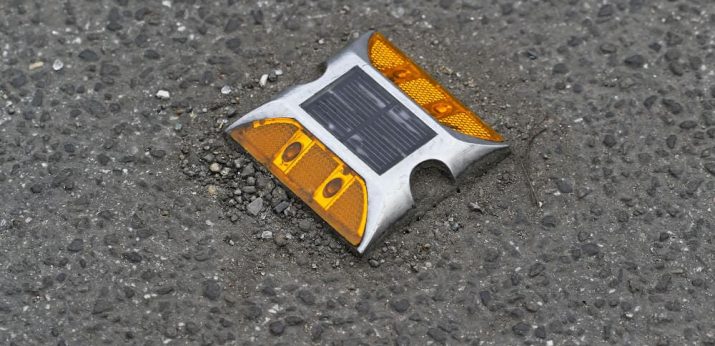Have you ever driven down an unfamiliar road and struggled to distinguish the lane markings? Or maybe you’ve been on a nighttime expressway and experienced difficulty in spotting the upcoming bends in the road?
If you have, then you recognize the significance of road markings being clearly visible, particularly in low-light situations.
This is where reflective pavement markers come into play. Over the next few minutes, we will guide you through the various roles reflective pavement markers play in road safety. You get to learn the importance of reflective pavement markers, the different types available in the market, as well as the pros and cons of each.
The Need for Reflective Pavement Markers
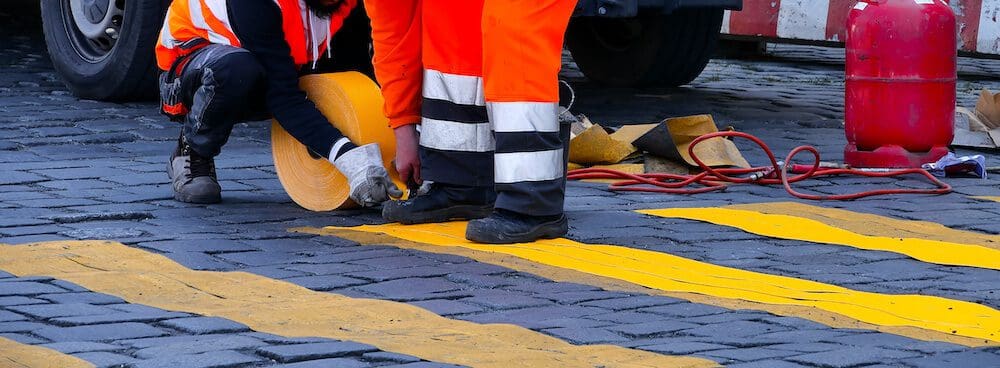
Reflective pavement markers are used on roads to enhance driver visibility. They feature a plastic or metal housing containing reflective substances, which bounce off light from vehicle headlights back towards the driver.
These markers are available in an array of materials and configurations, including paints, cold-applied plastics, thermoplastics, self-adhesive tapes, and modified epoxy resins
You’ve likely seen them utilized for purposes such as two-lane centerlines, lane lines on multilane highways, traffic islands, pavement arrows, exit ramp delineation, construction zones, and high-hazard locations like sharp or reverse curves.
The primary objective of these markers is to provide drivers with clear guidance on the layout of the road. Drivers rely on them to identify lane markings, centerlines, and edge lines – which ultimately helps to prevent accidents.
Studies, such as one conducted by the Texas Transportation Institute, have shown that the use of reflective pavement markers can indeed improve lane discipline, reduce lane changes, and result in smoother traffic flow.
The importance of reflective pavement markers even increases significantly in low-light conditions, thanks to the retroreflectivity of the embedded glass beads or prismatic sheeting.
When headlights shine on the markers, the glass beads or prisms reflect light back towards the driver, making the markings appear brighter and more visible. This retroreflection makes nighttime navigation easier for drivers.
Research by the National Cooperative Highway Research Program (NCHRP) suggests that reflective pavement markers can reduce nighttime crashes by up to 30%.
Types of Reflective Pavement Markers
Reflective pavement markers come in various types, each with its own set of strengths and weaknesses. Your selection should be based on factors like climate, traffic volume, and location.
That said, the three main types are:
- Raised pavement marker
- Solar-powered pavement markers
1. Raised pavement markers
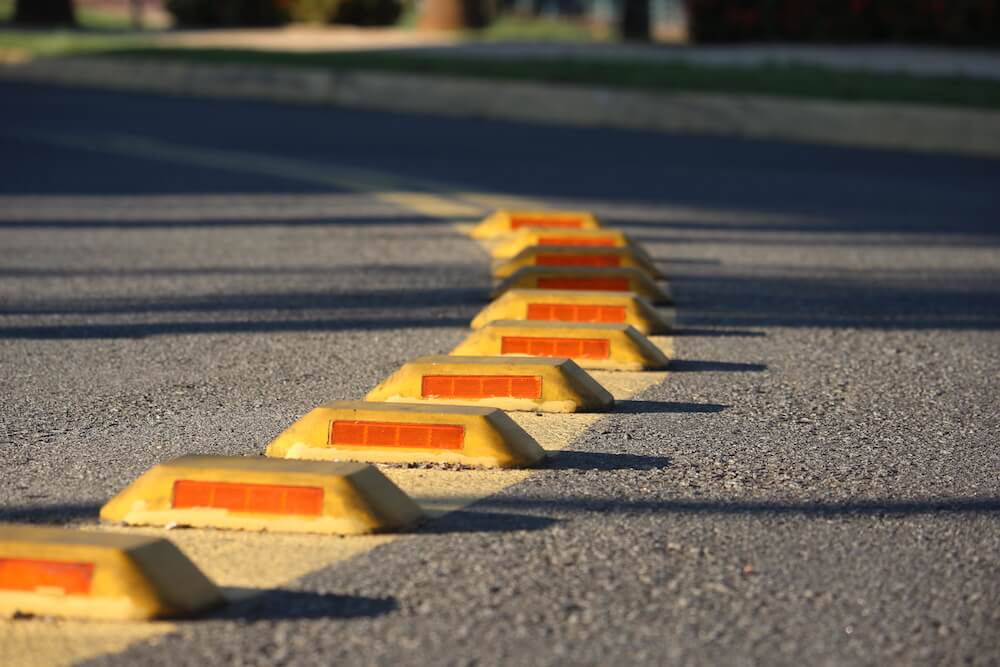
Raised pavement markers (RPMs) enhance safety by providing both retroflection and tactile feedback on pavement surfaces. They serve as a visible and tactile guide for drivers, alerting them of changes in lane or road conditions.
The reflective pavement markers in this category are typically made of ceramic, plastic, or metal.
Ceramic raised pavement markers (RPMs) offer great durability, making them perfect for areas with heavy traffic, while plastic RPMs provide a lightweight solution for temporary use or locations with less traffic. In contrast, metal RPMs are often utilized in areas that experience substantial snowfall or frequent plow usage. Tactile RPMs, which include raised studs or bars, provide extra assistance to drivers, particularly those who have vision impairments.
All these types of raised pavement markers are used in almost every state and city. One example is the Illinois Department of Transportation, which installed ceramic RPMs on a stretch of I-74 to improve visibility and safety. Then in areas like Boston, Massachusetts, you’ll find tactile raised pavement markers at multiple intersections. The city installed them to enhance accessibility for visually impaired pedestrians.
2. Solar-powered pavement markers
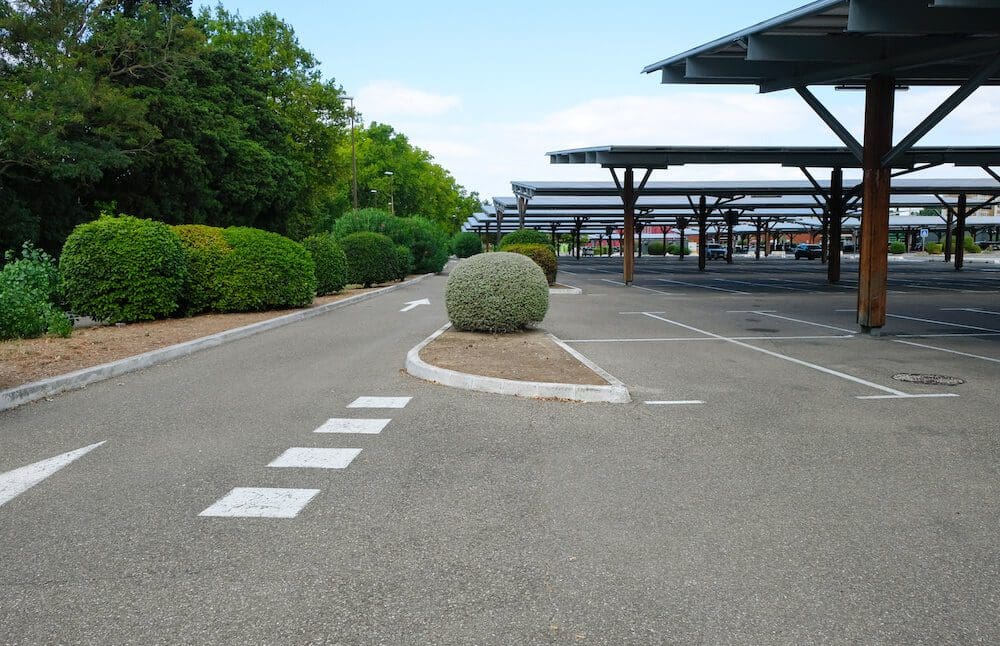
Solar-powered pavement markers (SPPMs) utilize solar energy to power embedded LED lights. They feature a durable casing made of polycarbonate, aluminum, or stainless steel on the surface. A solar panel is connected to the casing, from where it charges the battery that powers the integrated LED lights.
The lights themselves produce brilliant illumination that can be seen from afar, even in situations with poor lighting. Therefore, you may want to consider installing them in areas where high visibility is crucial, like bends, hazardous road segments, or fast-moving lanes.
SPPMs are available in three types – single-sided, double-sided, and tactile solar-powered pavement markers. Single-sided SPPMs are visible from one side of the marker and are perfect for delineating lanes or curves. Double-sided SPPMs maintain visibility on both sides of the marker, making them suitable for centerlines and crosswalks. Tactile SPPMs protrude slightly above the road surface, providing easy physical detection and guidance for visually impaired individuals.
One real-world example of SPPMs is the Minnesota Department of Transportation, which installed double-sided SPPMs to mark the centerline on a rural highway. The markers were chosen due to their high visibility and low maintenance requirements.
Temporary vs Permanent Reflective Pavement Markers
When categorized by longevity, reflective road pavement markings fall into two categories:
- Temporary reflective pavement markers.
- Permanent reflective pavement markers.
Temporary RPMs are usually made of plastic or rubber, which is secured to the road surface with adhesive backing. They are easy to install and remove, but less durable than permanent RPMs.
When exposed to harsh weather conditions or heavy traffic, these road pavement markings will wear out quickly. As such, you can only count on them for short-term applications – such as road construction, maintenance, and repair projects.
Permanent reflective pavement markings, on the other hand, are built from ceramic, glass, or metal. They’re installed using an adhesive or epoxy, which permanently binds them to the road surface. This strong bond helps them withstand heavy traffic and harsh weather conditions better than their temporary counterparts.
But, while permanent markings are more durable than temporary RPMs, they happen to be costlier and less customizable. Only a professional installer with specialized equipment can work with them.
Nevertheless, both types of RPMs enhance road safety and navigation. The decision between the two options hinges on the particular needs of the project or use case. Temporary RPMs are designed for brief roadwork endeavors, whereas permanent RPMs are the preferred choice for long-term and heavily-trafficked applications.
Reflective Pavement Markers Maintenance and Best Practices
Regular maintenance is extremely important for the effectiveness and longevity of reflective pavement markers.
Dirt or debris, for instance, could significantly reduce the visibility of reflective road markings, while damaged or dislodged RPMs may be as effective in guiding drivers. Therefore, to prevent safety hazards, RPMs should be cleaned regularly, and any damage or dislodgement ought to be repaired immediately.
The frequency of cleaning will depend on the location and weather conditions. But, regardless of the schedule, ensure that you’ve washed your reflective pavement markers carefully with a soft-bristled brush, soap, and water. Hard bristles could otherwise scratch their retroreflective surface.
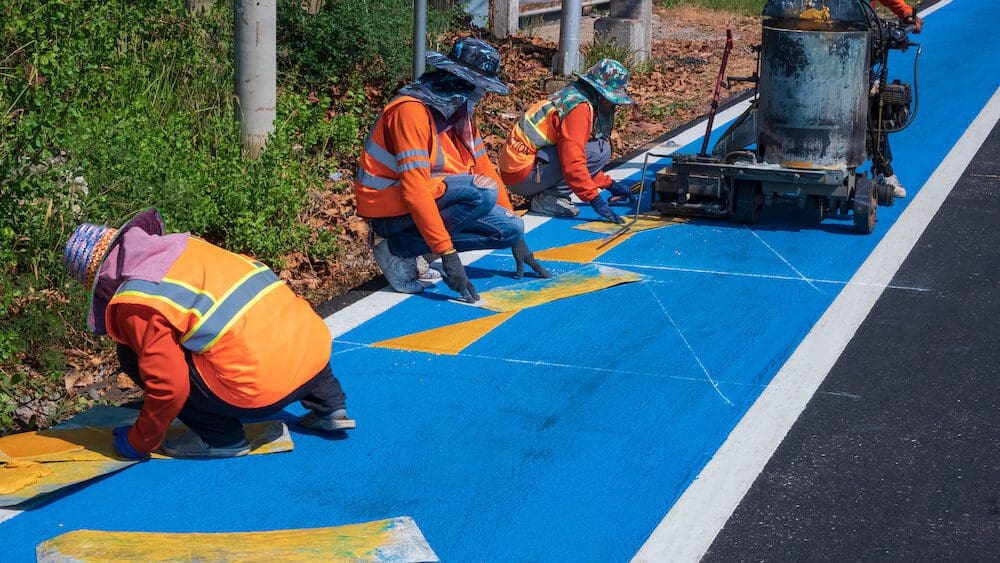
When making repairs, you must always proceed with the appropriate adhesive or epoxy. The reflective road markers should also be aligned and leveled accordingly to maintain optimal reflectivity.
Installations, on the other hand, are best left to trained professionals. They’re the only ones with the right skills and techniques for the job. Road surfaces should first be cleaned and dried to ensure proper bonding of the materials. RPMs should then be installed at the right height and spacing. This guarantees high reflectivity, even in low visibility conditions.
In the Market for Reflective Pavement Markers?
The importance of reflective pavement markers cannot be overstated when it comes to road safety. They continue to provide drivers with clear guidance on the road layout, especially in low-light conditions. Research too has proven that they’ve indeed reduced the occurrence of road traffic accidents at night.
So, all factors considered, reflective pavement markers are a must-have for any road safety plan.
To choose the most appropriate type, you should always consider the application, climate, traffic volume, and location. Raised pavement markers offer both retroflection and tactile feedback, recessed markers are installed flush with the pavement surface and are less prone to physical damage, while solar-powered markers utilize solar energy to power embedded LED lights.
Whichever you settle for, you’re guaranteed to get it here. Transline Industries offers a complete range of pavement marking materials, traffic control equipment, and road signs.




